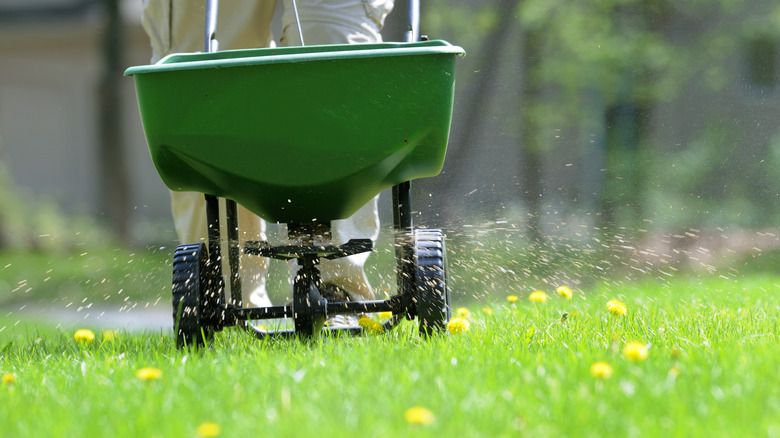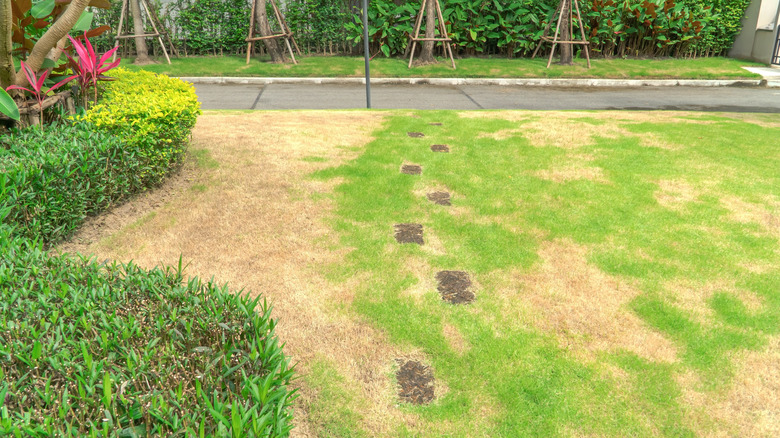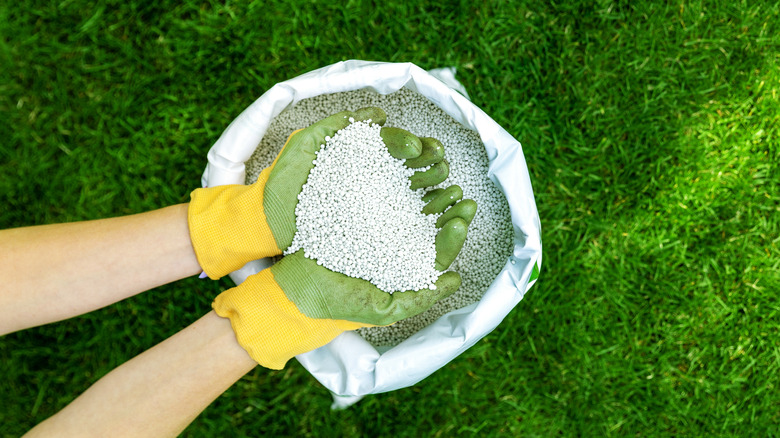Why You Shouldn't Weed And Feed Your Lawn In Midsummer
Taking care of your lawn is a year-round endeavor. Encouraging lawn growth by putting down fertilizer strengthens the existing plants, as does eliminating weeds by using chemicals. If you are interested in applying granules to try to improve the performance of your lawn — a weed and feed treatment — it works better to deliver these chemicals and nutrients at the right time of the year. Although you can put down granules in the hottest part of summer, they don't provide as much benefit as they do at other times of the year because of the high temperatures. By applying these products in midsummer, you could be spending money unnecessarily because the granules are ineffective, or you could even do damage to your lawn.
Applying the product at the right time of the year lessens the risk that the product could damage the grass. Certain weed killers that you use in your yard are meant to kill weed plant seeds before they can sprout and germinate. Others have a post-emergent formula that kills weeds after they sprout or as they are actively growing in the lawn. They often have a slow-release formula, which allows the product to remain in place for weeks, which makes overusing them risky.
Bottom line: Using weed and feed granules at the proper time is perfectly safe. But if you use them too close to the last time you used them or when temperatures are too high, they could cause damage.
Potential issues when applying weed and feed in midsummer
One of the biggest problems with applying a weed and feed product in the middle of summer is that temperatures typically are too high for the granules to work as intended. These granules tend to lose their effectiveness in hot weather. Check the instructions for the granules that you purchased for any recommendations on usage in certain temperatures, but many weed and feed products are not recommended for use in temperatures higher than 85 degrees Fahrenheit. Applying your weed and feed product in the early spring and early fall typically means temperatures will be below 85 degrees while putting them down in summer often occurs during higher temperatures.
Additionally, allow at least two months to pass before applying another combined fertilizer and weed killer product, or you could end up doing damage to the grass rather than benefiting it. A buildup of the herbicides used to attempt to eliminate the weeds could harm the root system of the grass.
Another potential problem occurs from the overuse of the fertilizer portion of these products. If you already used it in the spring, adding the same formula in the middle of summer could lead to having too much nitrogen, potassium, and salt in the soil. The slow-release nutrients from the spring application are potentially still in the soil at the time you apply the weed and feed in the summer, so adding more could end up damaging the grass.
How to apply your weed and feed product at the correct time of the year
It's important to fertilize your lawn at the right time of the year for maximum benefit. Most weed and feed products have a formula that's meant to feed the lawn and eliminate weeds in the spring and fall.
Putting down the product for the first time in the growing season should happen just about the time that the grass is starting to grow. Applying it before early spring could be too early to catch weeds before they begin sprouting, meaning your application won't be as effective. If you use it later than early spring, the grass plants may not receive the nutrients they need to grow healthy. With the second application in the early fall, the granules are able to attack persistent weeds that sprout year after year. The fertilizer also provides nutrients for the grass plants and roots to survive the winter.
Some lawn care professionals will recommend putting down a grub control product on the lawn in the early or midsummer rather than using a traditional weed and feed formula. Along with the grub control, manufacturers often package a type of fertilizer specifically made for summer. Often, this summer formula may not use potassium, for example. Potassium is better to use when entering and exiting the harsh weather of winter, which is why it's often part of a weed and feed formula rather than a summer formula.


